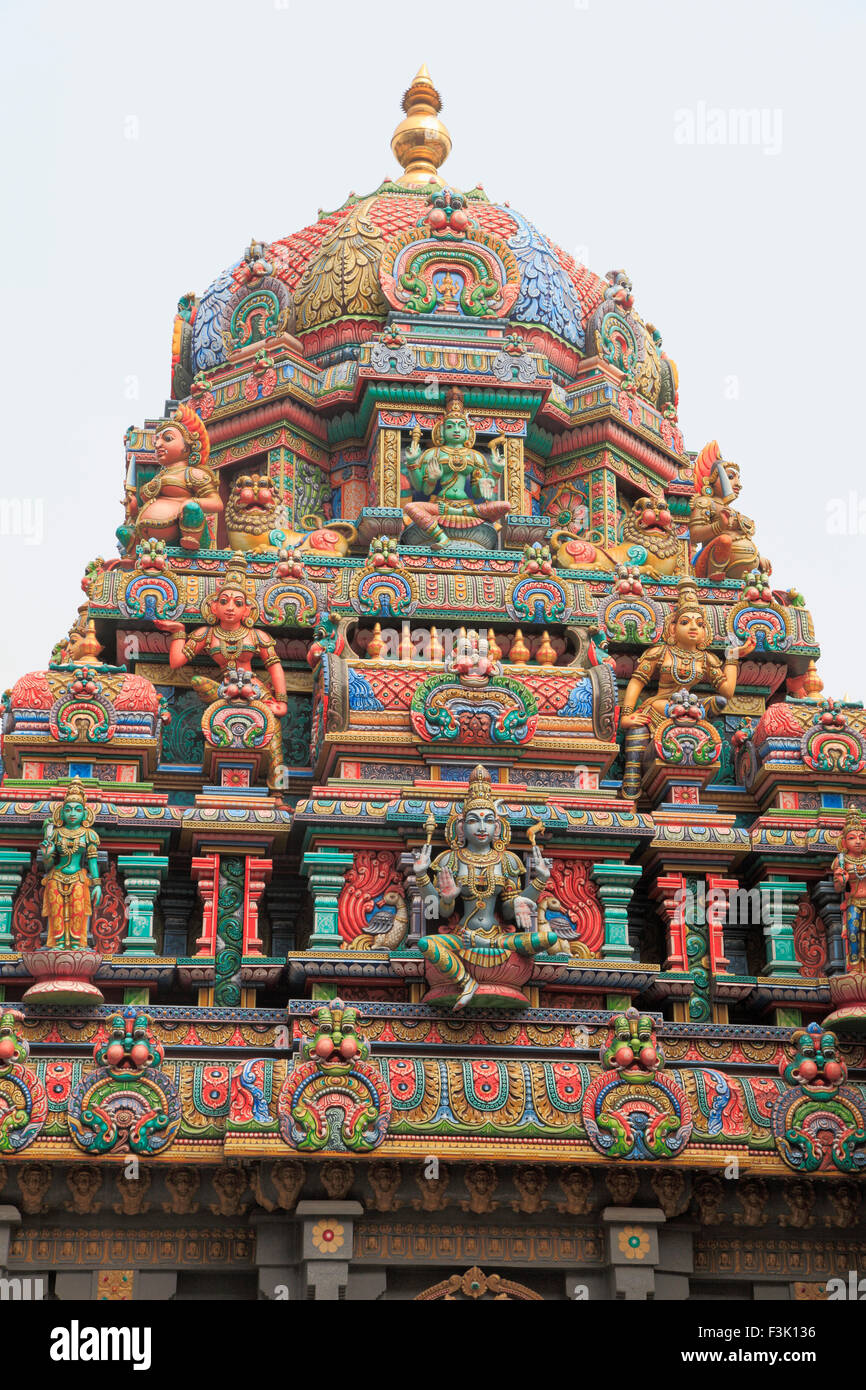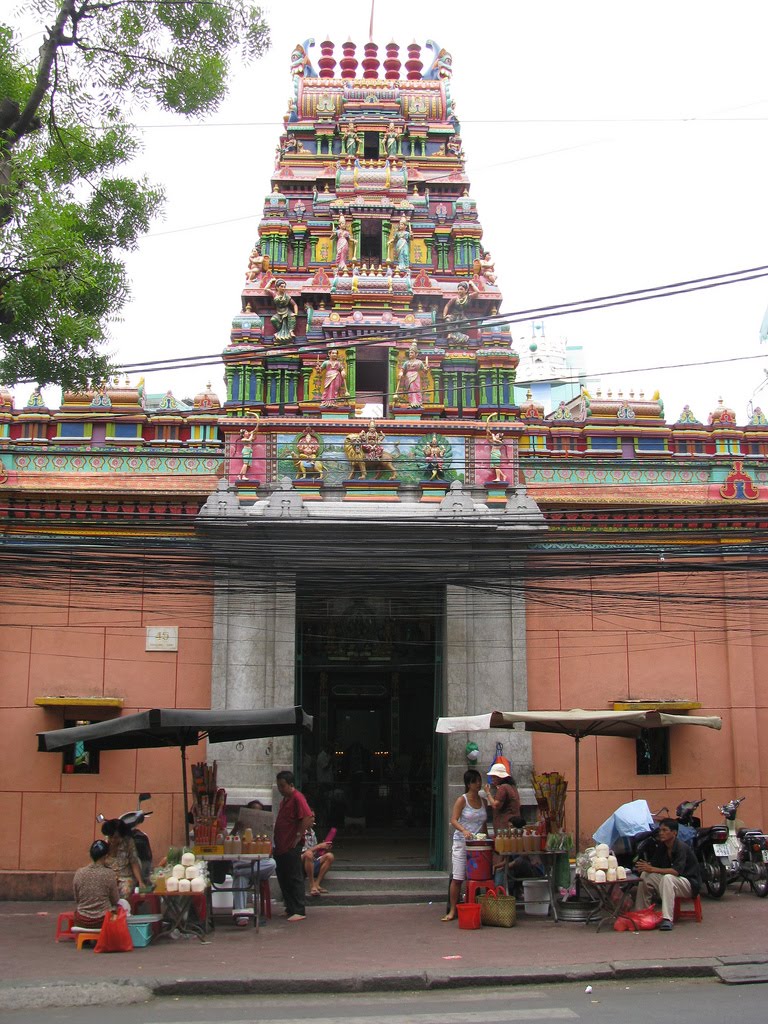


23 Hindu temples usually have shrines for different deities. 22 Within the grounds are several domes called vimanam, which mark the location of shrines or altars beneath it. The entrance is a pair of timber doors flanked by two square pillars. The top of the boundary wall that surrounds the compound is lined with sculptures of cows, an animal that Hindus consider sacred. The entrance was rebuilt in the 1930s, and repaired and decorated with the present sculptures in the ’60s. 20 The statues of Shiva and Vishnu were installed at the sides of the original three-storey gopuram in 1903. 19 The latter, however, were replaced with figures donning traditional Indian costumes during a renovation in 1971. 18 Its five tiers feature three-dimensional sculptures of Hindu deities in relaxed poses, and used to have statues of sepoy soldiers wearing khaki uniforms inspired by the military tradition of the British raj. 17 The elaborately decorated gopuram, or entrance tower, is a landmark in the area. Pagoda Street and Temple Street currently flanking the temple gained their names from this ornate building. 15 Much of the present building is believed to date from 1862/63, constructed by Indian and Chinese craftsmen. The temple has since undergone several rounds of renovations and additions. 14 Besides being a place of worship, the temple was also closely intertwined with the Hindu community as it served as a first refuge for new immigrants, dispute mediation venue, and an early registry of marriages for Hindus. “Mari”, meaning “rain” in Tamil, is an important life-giving element in rural life, while Goddess Mariamman is also known as the curer of diseases. 12 The walkway between the main entrance and the building was once covered by attap, but this was destroyed by a fire in 1910. In 1843, this wood-and-attap temple was replaced with a brick structure built by Indian convict labour. The site was then expanded in 1831 with a land donation by an Indian landowner, Seshasalam Pillai. 11Ī temple made of wood and attap (palm fronds) was completed in 1827, with a small deity installed by Pillai. 10 Back then, southern Indians were referred to as “klings” or “kelings”, and Indian temples were marked as such. 9 It was marked out as “Kling Chapel” in Lieutenant Philip Jackson's first town plan of Singapore drawn up in 1823, and published in 1828. In 1823, the present South Bridge Road site was granted. The British East India Company had allotted a plot on Telok Ayer Street for a Hindu temple, but it was deemed unsuitable as freshwater supply required for rituals were unavailable nearby. With the assistance of Raffles, he revived his business in Commercial Square (later renamed Raffles Place). 7 Pillai’s business suffered greatly in 1822 when a fire destroyed his shop on Cross Street. Pillai was a government clerk from Penang 6 who accompanied Stamford Raffles to Singapore in 1819. 4 Sri Mariamman Temple, managed by the Hindu Endowments Board, was gazetted as a national monument on 28 June 1973. 3 Originally a wood-and-attap structure, the temple was reconstructed with bricks in 1843. 2 The temple was established by Indian pioneer Naraina Pillai (also spelt Narayana Pillay) in 1827. 1 Commonly referred to as Mariamman Kovil (“Mariamman Temple” in Tamil), the temple was constructed for the worship of Goddess Mariamman by immigrants from the Nagapattinam and Cuddalore districts of South India.

Devotees would walk barefooted on the hot coals as a test of their faith and devotion.Sri Mariamman Temple on South Bridge Road is the oldest Hindu temple in Singapore. Today, Sri Mariamman Temple is best known for the fire-walking ceremoney, or Theemithi, that is helf every October or November. Located in the heart of Chinatown, the temple’s ornamental tower entrance or gopuram, has been a landmark to generations of Hindu worshippers and Singaporeans alike from 1930s. In 1823, Pillai requested for some land to built a temple, but it was only in 1827 that the first temple building was erected. Sri Mariamman Temple was established by Narayana Pillai, who came to the settlement with Stamford Raffles' party in 1819. The temple is dedicated to Goddess Mariamman, known for her power in curing epidemic illnesses and diseases, the temple attracted many devotees, who turned to her power of healing. In the early years, it provided shelter for Indian immigrants, and was the only Hindu temple whose priests were vested with the authority to solemnise Hindu marriages. Built in 1827, Mariamman Kovil or Kling Street Temple as it was popularly known then was constructed for worship by immigrants from the Nagapatnam and Cuddalore districts of South India. Sri Mariamman Temple is the oldest Hindu temple in Singapore.


 0 kommentar(er)
0 kommentar(er)
